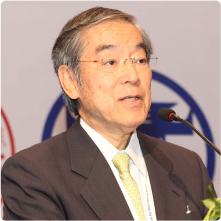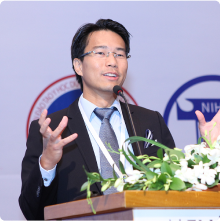Date: 10 June 2015
Location: Melia Hotel, Hanoi, Viet Nam
APACI’s 2nd Asia-Pacific Antiviral Forum was held in Hanoi, Viet Nam on 10 June 2015. Over 160 delegates from 33 countries attended the meeting.
We have listed here the abstracts and presentations from the Forum.
Welcome and introduction: current knowledge on neuraminidase inhibitors effectiveness.

Clinical Professor David Smith. (Australia)
David Smith is an APACI Director, Clinical Virologist at PathWest Laboratory Medicine WA, Director of PathWest services at the Queen Elizabeth II Medical Centre, and a Clinical Professor in the Faculty of Medicine, Dentistry and Health Sciences at the University of Western Australia. His other roles include Director of the National Influenza Centre at PathWest and Chair of the Public Health Laboratory Network of Australia, as well as being a member of a number of professional and expert advisory committees.
PresentationReview of antiviral treatment for mild and severe influenza infections in children.

Associate Professor Tawee Chotpitayasunondh. (Thailand)
Dr Tawee Chotpitayasunondh is Associate Professor (Honour), Senior Medical Officer and a paediatric infectious diseases specialist consultant at the Queen Sirikit National Institute of Child Health, Ministry of Public Health, Thailand. A/ Professor Chotpitayasunondh gained his medical degree from Siriraj Hospital, Mahidol University, Thailand, and has been a paediatric infectious diseases specialist for 35 years. His particular areas of interest include vaccines, tuberculosis, HIV/AIDS, antibiotics and influenza, emerging infectious diseases and he has served as a WHO temporary consultant on paediatric HIV/AIDS, antivirals, avian/pandemic influenza.
PresentationHigher-dose oseltamivir treatment in adults hospitalized with influenza A and B infections.

Clinical Professor Paul Chan. (Hong Kong)
Professor Paul Chan is Clinical Professor and Chairman of the Department of Microbiology, and Deputy Director of the Stanley Ho Centre for Emerging Infectious Diseases, Faculty of Medicine, the Chinese University of Hong Kong. He is also an Honorary Consultant in Microbiology for the New Territories East Cluster Hospitals of the Hong Kong Hospital Authority. Professor Chan is a renowned clinical virologist with special interest in tumour virology and human respiratory viruses. He serves many key professional bodies in Hong Kong, including the Scientific Committee on Emerging and Zoonotic Diseases of the Centre for Health Protection, the Grant Review Board for Medical and Health Research Fund, the Advisory Council on Food and Environmental Hygiene, Working Groups for Human Papillomavirus and Rotavirus Vaccines, and the Hong Kong College of Pathologists Examiner Committee.
PresentationEmerging and antiviral-resistant influenza infections: new drug development and therapeutic options.

Clinical Professor Dominic Dwyer. (Australia)
Dr Dominic Dwyer is a medical virologist and infectious diseases physician, and is Director of the Centre for Infectious Diseases and Microbiology Laboratory Services, ICPMR, Westmead Hospital in Sydney, Australia. He undertook postgraduate research in HIV at the Institut Pasteur in Paris, France. He has a clinical and research interest in viral diseases of public health importance, and runs a clinical trials unit in antiviral drugs and vaccines. He has a particular interest in antiviral drug resistance. He is a Clinical Professor at the Western Medical School, Sydney University. He assists State and National governments in planning for pandemic influenza and emerging infections, and is actively involved in outbreak investigations .He has undertaken various overseas projects, including with the World Health Organization during the SARS outbreak in Beijing, with the Australian Government in Vietnam for avian influenza and the Maldives for tsunami relief, with the University of Sydney in Malaysia and the Sudan for HIV, and for public health regulatory bodies in New Zealand and Hong Kong. He is a member of the WHO Global Outbreak Alert Response Network (GOARN), and the Sydney Institute for Emerging Infectious Diseases and Biosecurity at Sydney University.
Present situation on influenza diagnosis and treatment in Japan.

Professor Norio Sugaya. (Japan)
Norio Sugaya, M.D., Ph.D., is a professor of Keio University School of Medicine and the director of the Department of Infection Control and the Department of Pediatrics, Keiyu Hospital, Yokohama, Japan. He received his Ph.D. from the Keio University School of Medicine for a thesis on diagnostic testing for influenza. He has been active in the area of influenza diagnosis, treatment with neuraminidase inhibitors, influenza vaccines, and the epidemiology of influenza for over 30 years. His international experience includes participation as a panel member of Rapid Advice Guidelines on pharmacological management of humans infected with avian influenza A (H5N1) virus, held at World Health Organization in 2006 and as a panel member of Pharmacological Management of Pandemic Influenza A (H1N1), held in 2009-2010 at World Health Organization. He is also a member of Multinational Influenza Seasonal Mortality Study of NIH/FIC. In Japan, he is a central member of committees for influenza under the auspices of the Japanese Association for Infectious Diseases. He has done much to establish universal early treatment with neuraminidase inhibitors in Japan.
Abstract
Since the approval of zanamivir for use in influenza virus infection in Japan in 1999, and of oseltamivir in 2000, rapid diagnostic tests have been routinely performed by clinicians in patients who have an influenza-like illness, and patients with positive test results, including otherwise healthy adults and children without any underlying illness, have usually been treated with neuraminidase inhibitors.
In Japan, the most characteristic is widespread use of rapid diagnostic tests for influenza, together with the use of NAI. By use of the rapid diagnostic test for influenza, Japanese clinicians can diagnose influenza with accuracy, and prescribe NAI with assurance. Cost of rapid diagnostic test and neuraminidase inhibitor treatment are substantially covered by the public health insurance systems in Japan.
Several problems attendant on widespread use of neuraminidase inhibitors in Japan, a situation not seen anywhere else in the world, is discussed.
PresentationAntiviral resistance surveillance: a global program.

Associate Professor Aeron Hurt. (Australia)
A/Prof Aeron Hurt has been a research scientist for the WHO Collaborating Centre for Reference and Research on Influenza, Melbourne for over 15 years and currently heads the Antiviral Susceptibility Analysis unit of the Centre. A/Prof Hurt has authored over 90 publications in the field of influenza, predominantly in the fields of antiviral resistance, influenza surveillance, diagnostics, and influenza evolution. These include publications in high impact journals such as Science, Nature and New England Journal of Medicine. Aeron has been appointed as a member of various scientific committees including the WHO Influenza Antiviral Expert Working Group and the isirv-Antiviral Group where he provides advice on antiviral use and drug resistance. A/Prof Hurt has also performed numerous Temporary Advisory roles for the World Health Organisation HQ (Geneva) or the Western Pacific Regional Office (Manila), relating to providing advice and expertise on antiviral resistance and laboratory database management and influenza laboratory detection. A/Prof Hurt has supervised numerous post-graduate students, and currently holds an Adjunct Principle Fellow position at the University of Melbourne.
Effectiveness of antiviral stockpiles for pandemic preparedness.

Associate Professor Vernon Lee. (Singapore)
A/Prof Vernon Lee is a preventive medicine physician and adjunct Associate Professor at the Saw Swee Hock School of Public Health, National University of Singapore. He is also Head of the Singapore Armed Forces Biodefence Centre, and Deputy Director for Communicable Diseases in the Ministry of Health, Singapore. He was previously Advisor to the Assistant Director General for Health, Security and Environment at the World Health Organization headquarters; and Medical Epidemiologist in the WHO Office in Indonesia. A/Prof Lee graduated from medical school at the National University of Singapore, and also holds a PhD in epidemiology from the Australian National University, and the Master in Public Health and Master of Business Administration degrees from the Johns Hopkins University, USA
Abstract
Many countries across the world have been stockpiling on antivirals against influenza for preparedness against a future influenza pandemic. These antivirals have been considered for use as treatment or prophylaxis during a pandemic. There is a substantial body of scientific and clinical evidence for the use of antivirals for the treatment of individual influenza patients, but little real-life evidence of the effectiveness of antiviral prophylaxis exists, and also little evidence of the overall effectiveness of these antiviral strategies in reducing the pandemic’s impact. As such, countries have built their stockpiles based on mathematical modelling studies to provide an indication on how these antivirals can be deployed. This presentation explores some of the key modelling studies that have influenced stockpiling decisions and pandemic preparedness, including the combined use of antivirals with other public health interventions. It also explores recent studies during the 2009 pandemic and how these may change the way stockpiles are deployed.
Presentation
APACI wishes to thank Roche for their generous support


